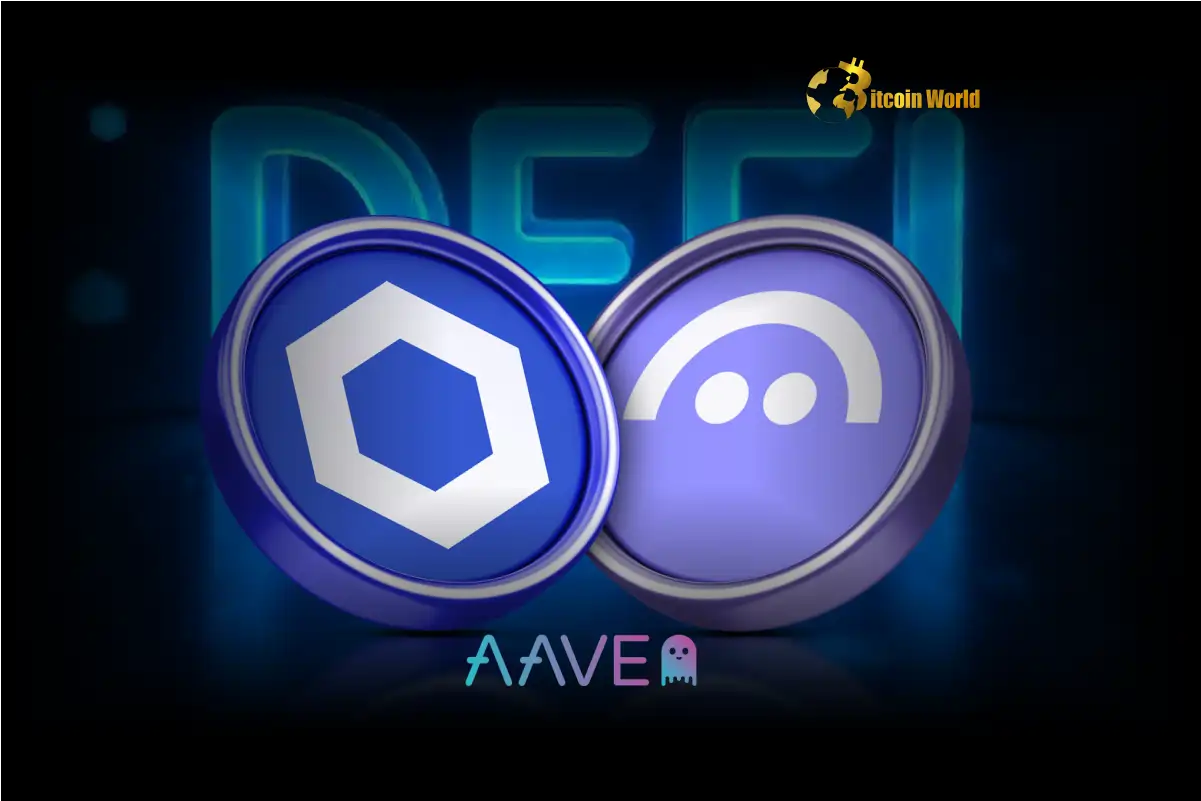Unlock DeFi Revenue: Aave Integrates Chainlink SVR to Combat MEV
1
0

In the fast-paced world of Decentralized Finance (DeFi), maximizing revenue and ensuring protocol sustainability are paramount. Aave, a leading DeFi lending platform, has taken a significant stride in this direction. By strategically integrating Chainlink’s Smart Value Recapture (SVR), Aave is set to tap into a previously underutilized source of income: Miner Extractable Value (MEV) associated with oracle services. This innovative move not only promises to boost Aave’s protocol revenue but also sets a new precedent for sustainable DeFi economics.
Decoding DeFi MEV and Its Impact
Miner Extractable Value (MEV), often referred to as Maximum Extractable Value, represents the profit that can be extracted by blockchain validators (miners or stakers) from reordering, including, or excluding transactions within a block. In the context of DeFi, MEV can arise from various activities, including:
- Liquidation Exploitation: When a user’s collateral in a lending protocol falls below the required threshold, liquidators can execute transactions to seize the collateral at a discount. This process, while necessary for protocol solvency, can sometimes be front-run or exploited to extract MEV.
- Arbitrage Opportunities: Price discrepancies across different decentralized exchanges (DEXs) create arbitrage opportunities. Bots can quickly execute trades to profit from these differences, potentially generating MEV.
- Oracle Manipulation: In certain scenarios, if oracle updates are delayed or predictable, sophisticated actors might attempt to manipulate on-chain data feeds temporarily for profit.
While some forms of MEV are inherent to the functioning of decentralized markets, excessive or unfairly extracted MEV can be detrimental to users and the overall health of a DeFi ecosystem. Aave’s integration of Chainlink SVR directly addresses the MEV associated with oracle liquidations, aiming to recapture this value and redirect it back into the protocol and its community.
Chainlink SVR: A Novel Solution for Oracle MEV
Chainlink’s Smart Value Recapture (SVR) is a cutting-edge solution designed to mitigate and recapture oracle-related MEV. It works by:
- Identifying MEV Opportunities: SVR is designed to detect potential MEV opportunities arising from oracle updates, specifically in scenarios like liquidations.
- Capturing MEV: Instead of allowing external actors to capture this value, SVR mechanisms aim to capture it on behalf of the protocol.
- Redistributing Revenue: The recaptured MEV is then redistributed according to predefined rules, often benefiting the protocol itself and the oracle providers.
In essence, Chainlink SVR transforms a potential loss (MEV extracted by external parties) into a revenue-generating opportunity for DeFi protocols like Aave. This is achieved through smart contract logic that strategically manages oracle updates and liquidation processes.
The Power of Aave Integration with Chainlink SVR
Aave’s decision to integrate Chainlink SVR marks a pivotal moment in DeFi, highlighting a proactive approach to protocol revenue generation and sustainable economics. Let’s delve into the key benefits:
- Enhanced Protocol Revenue: By recapturing oracle-related MEV, Aave unlocks a new revenue stream. This additional income can be reinvested into the protocol, used for community rewards, or contribute to further development and innovation.
- Sustainable DeFi Economics: SVR promotes a more sustainable DeFi model by ensuring that value generated within the ecosystem is retained and redistributed within the ecosystem, rather than being extracted solely by external actors.
- Fairer Liquidation Process: While liquidations are a necessary part of lending protocols, SVR can contribute to a fairer process by reducing the potential for predatory MEV extraction during liquidation events.
- Strengthened Aave and Chainlink Ecosystems: The revenue sharing mechanism between Aave and Chainlink communities fosters a stronger symbiotic relationship, benefiting both protocols and their respective stakeholders.
- Industry Leadership and Innovation: Aave’s adoption of Chainlink SVR positions them as an industry leader in DeFi innovation, showcasing a commitment to optimizing protocol performance and user experience.
To illustrate the impact, consider a hypothetical scenario. Imagine daily liquidations on Aave generate, on average, $1,000 in oracle-related MEV that is typically captured by bots. With Chainlink SVR, a significant portion of this $1,000 can now be recaptured and directed back to the Aave protocol and Chainlink network, translating to substantial annual revenue gains.
Navigating the Landscape of Oracle MEV: Challenges and Considerations
While the integration of Chainlink SVR presents significant advantages, it’s crucial to acknowledge potential challenges and considerations:
- Complexity of Implementation: Implementing SVR requires careful smart contract design and integration to ensure it functions effectively and securely without introducing new vulnerabilities.
- Gas Costs: Mechanisms to capture and redistribute MEV might introduce additional gas costs. Optimizing these processes to minimize gas consumption is essential.
- Transparency and Monitoring: Clear mechanisms for tracking and reporting recaptured MEV are needed to maintain transparency and build trust within the community.
- Evolving MEV Landscape: The MEV landscape is constantly evolving. Continuous monitoring and adaptation are necessary to ensure SVR remains effective against emerging MEV strategies.
- Community Governance: Decisions regarding the distribution of recaptured MEV should ideally involve community governance to ensure alignment with the protocol’s long-term goals and values.
Despite these considerations, the potential benefits of recapturing oracle MEV for DeFi protocols like Aave are undeniable. As the DeFi space matures, such innovative solutions will become increasingly crucial for ensuring long-term sustainability and competitiveness.
Actionable Insights: What Does This Mean for DeFi Users and the Future?
Aave’s integration of Chainlink SVR offers several key takeaways for DeFi users and the broader ecosystem:
- For Aave Users: This integration strengthens the Aave protocol, potentially leading to increased revenue for the protocol, which could translate to enhanced services, lower fees in the long run, or other community benefits. It signals Aave’s commitment to innovation and optimizing user experience.
- For DeFi Protocols: Aave’s move serves as a compelling example for other DeFi protocols to explore MEV recapture strategies. Integrating solutions like Chainlink SVR can be a significant step towards building more sustainable and economically robust DeFi platforms.
- For Chainlink Community: The revenue sharing aspect strengthens the Chainlink ecosystem and incentivizes further development and innovation in oracle solutions. It showcases the value proposition of Chainlink oracles beyond just data provision, extending to MEV mitigation and revenue optimization.
- For the Future of DeFi: This integration represents a crucial step towards a more mature and efficient DeFi ecosystem. By addressing MEV and optimizing revenue streams, DeFi protocols can become more resilient, sustainable, and competitive with traditional financial systems.
Conclusion: A Bold Step Towards Sustainable DeFi
Aave’s integration of Chainlink Smart Value Recapture is more than just a technical upgrade; it’s a strategic move that underscores the evolving landscape of DeFi. By proactively addressing oracle-related MEV, Aave is not only enhancing its own protocol revenue but also contributing to the development of a more sustainable and equitable DeFi ecosystem. This innovative approach sets a new benchmark for how DeFi protocols can optimize their operations and ensure long-term viability in a dynamic and competitive market. As other protocols follow suit, we can anticipate a future where recapturing MEV becomes a standard practice, fostering a healthier and more prosperous DeFi space for all participants.
To learn more about the latest DeFi MEV trends, explore our article on key developments shaping DeFi innovation.
1
0
 Verwalten Sie alle Ihre Kryptowährungen, NFTs und DeFi an einem Ort
Verwalten Sie alle Ihre Kryptowährungen, NFTs und DeFi an einem OrtVerbinden Sie sicher das Portfolio, das Sie zu Beginn verwenden möchten.








